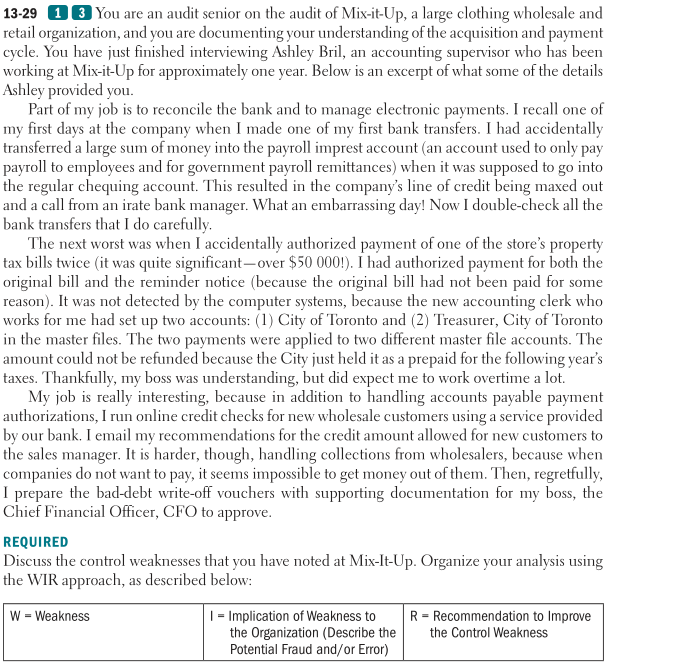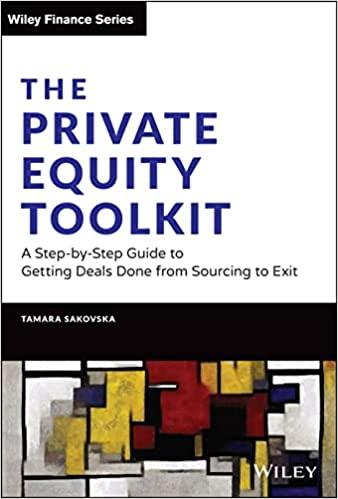
13-29 1 3 You are an audit senior on the audit of Mix-it-Up, a large clothing wholesale and retail organization, and you are documenting your understanding of the acquisition and payment cycle. You have just finished interviewing Ashley Bril, an accounting supervisor who has been working at Mix-it-Up for approximately one year. Below is an excerpt of what some of the details Ashley provided you. Part of my job is to reconcile the bank and to manage electronic payments. I recall one of my first days at the company when I made one of my first bank transfers. I had accidentally transferred a large sum of money into the payroll imprest account (an account used to only pay payroll to employees and for government payroll remittances) when it was supposed to go into the regular chequing account. This resulted in the company's line of credit being maxed out and a call from an irate bank manager. What an embarrassing day! Now I double-check all the bank transfers that I do carefully. The next worst was when I accidentally authorized payment of one of the store's property tax bills twice (it was quite significant - over $50 000!). I had authorized payment for both the original bill and the reminder notice (because the original bill had not been paid for some reason). It was not detected by the computer systems, because the new accounting clerk who works for me had set up two accounts: (1) City of Toronto and (2) Treasurer, City of Toronto in the master files. The two payments were applied to two different master file accounts. The amount could not be refunded because the City just held it as a prepaid for the following year's taxes. Thankfully, my boss was understanding, but did expect me to work overtime a lot. My job is really interesting, because in addition to handling accounts payable payment authorizations, I run online credit checks for new wholesale customers using a service provided by our bank. I email my recommendations for the credit amount allowed for new customers to the sales manager. It is harder, though, handling collections from wholesalers, because when companies do not want to pay, it seems impossible to get money out of them. Then, regretfully, I prepare the bad-debt write-off vouchers with supporting documentation for my boss, the Chief Financial Officer, CFO to approve. REQUIRED Discuss the control weaknesses that you have noted at Mix-It-Up. Organize your analysis using the WIR approach, as described below: W - Weakness | = Implication of Weakness to the Organization (Describe the Potential Fraud and/or Error) R = Recommendation to Improve the Control Weakness 13-29 1 3 You are an audit senior on the audit of Mix-it-Up, a large clothing wholesale and retail organization, and you are documenting your understanding of the acquisition and payment cycle. You have just finished interviewing Ashley Bril, an accounting supervisor who has been working at Mix-it-Up for approximately one year. Below is an excerpt of what some of the details Ashley provided you. Part of my job is to reconcile the bank and to manage electronic payments. I recall one of my first days at the company when I made one of my first bank transfers. I had accidentally transferred a large sum of money into the payroll imprest account (an account used to only pay payroll to employees and for government payroll remittances) when it was supposed to go into the regular chequing account. This resulted in the company's line of credit being maxed out and a call from an irate bank manager. What an embarrassing day! Now I double-check all the bank transfers that I do carefully. The next worst was when I accidentally authorized payment of one of the store's property tax bills twice (it was quite significant - over $50 000!). I had authorized payment for both the original bill and the reminder notice (because the original bill had not been paid for some reason). It was not detected by the computer systems, because the new accounting clerk who works for me had set up two accounts: (1) City of Toronto and (2) Treasurer, City of Toronto in the master files. The two payments were applied to two different master file accounts. The amount could not be refunded because the City just held it as a prepaid for the following year's taxes. Thankfully, my boss was understanding, but did expect me to work overtime a lot. My job is really interesting, because in addition to handling accounts payable payment authorizations, I run online credit checks for new wholesale customers using a service provided by our bank. I email my recommendations for the credit amount allowed for new customers to the sales manager. It is harder, though, handling collections from wholesalers, because when companies do not want to pay, it seems impossible to get money out of them. Then, regretfully, I prepare the bad-debt write-off vouchers with supporting documentation for my boss, the Chief Financial Officer, CFO to approve. REQUIRED Discuss the control weaknesses that you have noted at Mix-It-Up. Organize your analysis using the WIR approach, as described below: W - Weakness | = Implication of Weakness to the Organization (Describe the Potential Fraud and/or Error) R = Recommendation to Improve the Control Weakness







